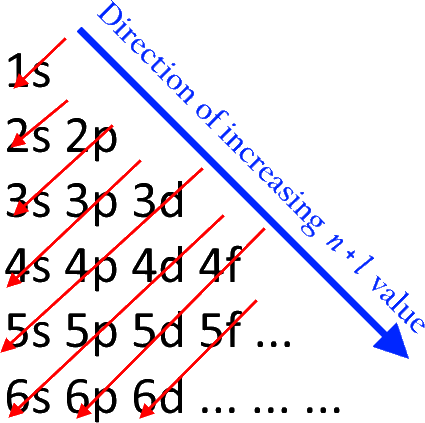
Which has an electronic configuration $1{s^2}2{s^2}2{p^6}3{s^2}3{p^1}$ ?
A. $N{a^ + }$
B. Al
C. F
D. Ti
E. B
Answer
138.3k+ views
Hint: The electronic configuration of an element describes how electrons are distributed in its atomic orbitals. The electronic configurations of atoms follow a standard notation in which all electron-containing atomic subshells are placed in a sequence.
Complete step by step answer:
The electronic configuration of an atom is written with the help of the subshell labels. Now, these labels contain the shell number (given by the principal quantum number), the subshell name, (given by the azimuthal quantum number) and the total number of electrons in the subshell in superscript.
For example if the two electrons are filled in the' subshell of the first shell, then the resulting notation is $1{s^2}$. The three rules that dictate the manner in which electrons are filled in atomic orbitals are Aufbau principle, Pauli’s exclusion principle and Hund’s rule.
In Aufbau principle, the electrons must completely fill the atomic orbitals of a given energy level before occupying an orbital associated with a higher energy.
In Pauli’s exclusion principle, no two electrons can have equal values for all four quantum numbers and each subshell of an orbital can accommodate a maximum of two electrons and both the electrons must have opposite spins.
In Hund’s rule, all the subshells in an orbital must be singly occupied before any subshell is doubly occupied.
The order in which the electrons are filled in atomic orbitals as per the Aufbau principle is as shown:

Now, among the given options Al is the correct option as, the atomic number of aluminum Is 13 and further, according the given rules, its electronic configuration is $1{s^2}2{s^2}2{p^6}3{s^2}3{p^1}$.
Hence, option B is correct.
Note:
The electronic configuration of copper is $[Ar]3{d^{10}}4{s^1}$. This configuration disobeys the aufbau principle due to the relatively small energy gap between the $3d$ and the $4s$ orbitals and chromium is also one such exception in this case. These exceptions can sometimes be explained by the stability provided by half-filled or completely filled subshells.
Complete step by step answer:
The electronic configuration of an atom is written with the help of the subshell labels. Now, these labels contain the shell number (given by the principal quantum number), the subshell name, (given by the azimuthal quantum number) and the total number of electrons in the subshell in superscript.
For example if the two electrons are filled in the' subshell of the first shell, then the resulting notation is $1{s^2}$. The three rules that dictate the manner in which electrons are filled in atomic orbitals are Aufbau principle, Pauli’s exclusion principle and Hund’s rule.
In Aufbau principle, the electrons must completely fill the atomic orbitals of a given energy level before occupying an orbital associated with a higher energy.
In Pauli’s exclusion principle, no two electrons can have equal values for all four quantum numbers and each subshell of an orbital can accommodate a maximum of two electrons and both the electrons must have opposite spins.
In Hund’s rule, all the subshells in an orbital must be singly occupied before any subshell is doubly occupied.
The order in which the electrons are filled in atomic orbitals as per the Aufbau principle is as shown:

Now, among the given options Al is the correct option as, the atomic number of aluminum Is 13 and further, according the given rules, its electronic configuration is $1{s^2}2{s^2}2{p^6}3{s^2}3{p^1}$.
Hence, option B is correct.
Note:
The electronic configuration of copper is $[Ar]3{d^{10}}4{s^1}$. This configuration disobeys the aufbau principle due to the relatively small energy gap between the $3d$ and the $4s$ orbitals and chromium is also one such exception in this case. These exceptions can sometimes be explained by the stability provided by half-filled or completely filled subshells.
Recently Updated Pages
How to find Oxidation Number - Important Concepts for JEE

How Electromagnetic Waves are Formed - Important Concepts for JEE

Electrical Resistance - Important Concepts and Tips for JEE

Average Atomic Mass - Important Concepts and Tips for JEE

Chemical Equation - Important Concepts and Tips for JEE

Concept of CP and CV of Gas - Important Concepts and Tips for JEE

Trending doubts
JEE Main 2025 Session 2: Application Form (Out), Exam Dates (Released), Eligibility, & More

JEE Main 2025: Derivation of Equation of Trajectory in Physics

Learn About Angle Of Deviation In Prism: JEE Main Physics 2025

Number of sigma and pi bonds in C2 molecule isare A class 11 chemistry JEE_Main

Electric Field Due to Uniformly Charged Ring for JEE Main 2025 - Formula and Derivation

JEE Main 2025: Conversion of Galvanometer Into Ammeter And Voltmeter in Physics

Other Pages
NCERT Solutions for Class 11 Chemistry Chapter 9 Hydrocarbons

NCERT Solutions for Class 11 Chemistry Chapter 7 Redox Reaction

JEE Advanced Marks vs Ranks 2025: Understanding Category-wise Qualifying Marks and Previous Year Cut-offs

NCERT Solutions for Class 11 Chemistry Chapter 5 Thermodynamics

Hydrocarbons Class 11 Notes: CBSE Chemistry Chapter 9

NCERT Solutions for Class 11 Chemistry In Hindi Chapter 1 Some Basic Concepts of Chemistry




